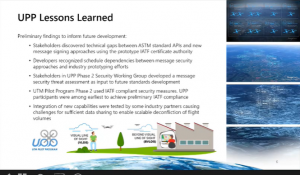By Jenny Beechener
“Public expectations are really important,” said European Aviation Safety Agency (EASA) Executive Director Patrick Ky at ICAO’s Drone Enable Symposium Day 3 session addressing lessons learned. “New types of aircraft are developing at a rapid pace and new business models are being built. The regulation needs to be in place.” The European Commission became the first region worldwide to adopt Unmanned Traffic Management (UTM) regulations that enable unmanned systems to interface with manned vehicles in April 2021. “Urban Air Mobility (UAM) is the next challenge, we expect in the 2023-24 timeframe,” added Patrick Ky.
Managing the perception of drones and UTM is central to progress said Gary Newman, Aviation Safety Inspector for UAE General Civil Aviation Authority (GCAA). “One person’s perception can be a game-breaker for systems and implementations and there is a disparity between public and industry perceptions.” He said in order to obtain positive buy-in, we need credible data including statistical data, analysis, cost benefit assessment, an appropriate regulatory framework and a roadmap. This calls for leadership, transparency, stakeholder consultation, realistic goal setting, credible planning, constant communication and deliverance on expected outcomes.
The US Federal Aviation Administration (FAA) has leaned heavily on its UTM Pilot Programme to support this process. According to FAA Chief Scientist Steve Bradford, through this industry partnership the agency was able to validate ASTM specification standards before the release of the Remote Identification ruling at the start of 2021 as well as validate future UTM architectures.
FAA Lessons Learned

“We all face limited resources,” said Prof Liu Hao, Vice-Chair of the Joint Authorities for Rulemaking on Unmanned Systems (JARUS). “JARUS works closely with other regulatory bodies. Industry plays a key in finding solutions to supplement the work by ICAO.”
Airbus Head of UTM Design Scot Campbell said simulation provides a fast and easy means to collect data, conduct stress testing and enables concept exploration. It is especially useful for end-to-end safety assurance – an area that deserves special attention in any proposal for a federated UTM system. “As we move to operationalise UTM, there has to be trust that the system will perform as expected, meet specific requirements and can be operated safely”.
Amazon Prime Air principal software engineer Robert Champagne also highlighted new challenges associated with high levels of automation. “In order to enable UTM at scale, a cloud-based solution is the only option, so we need to define a set of requirements.” Crucially, any cloud-based hardware needs to support the same levels of safety without the high costs associated with land-based architectures.
Unifly Co-Founder Koen Meuleman echoed the importance of establishing a viable business case for UTM service providers. “Stakeholders are looking for a return on their investment. Implementations today still focus on compliance with existing regulatory burdens, when they need to be future-proof.” He advocated a hybrid approach, staring with a single source of data before moving to a more federated UTM structure. “Key requisites are still missing today: Standardised data exchange, UTM performance requirements; connectivity; and interoperability with air traffic control.”
For more information visit:
https://www.icao.int/Meetings/DRONEENABLE4/Documents/Drone2021_VirtualEventDirectory.pdf




